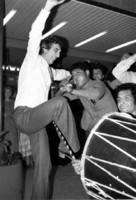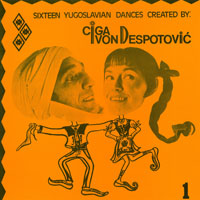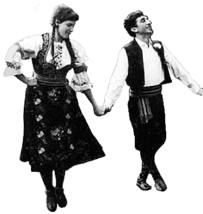|
Ciga and Ivon Despotović
|
|
 Miodrag "Ciga" Despotović, born in Belgrade (Beograd), Serbia, on June 30, 1929, was the youngest child in the family from Ivan and Katarina. He had two older sisters and one older brother, Ilija. Ciga's father, Ivan, came from a wealthy family in Macedonia. They made their fortune with sheep trading in the surroundings of Nikjivorivo in the Mavrovo district and lived a prosperous life. His father used to be called "Grov" Ivan (Count Ivan) by the locals, with reference to their wealth. Ciga and Ivon would create "Ivanovo Oro" as a tribute to his father's dancing skills. In Macedonia, Ciga went to school for one year. During his childhood Ciga was infected with children's cholera. He recovered in an amazing way; the elderly village women took him into the mountains and were able to cure his illness purely with herbal medications.
Miodrag "Ciga" Despotović, born in Belgrade (Beograd), Serbia, on June 30, 1929, was the youngest child in the family from Ivan and Katarina. He had two older sisters and one older brother, Ilija. Ciga's father, Ivan, came from a wealthy family in Macedonia. They made their fortune with sheep trading in the surroundings of Nikjivorivo in the Mavrovo district and lived a prosperous life. His father used to be called "Grov" Ivan (Count Ivan) by the locals, with reference to their wealth. Ciga and Ivon would create "Ivanovo Oro" as a tribute to his father's dancing skills. In Macedonia, Ciga went to school for one year. During his childhood Ciga was infected with children's cholera. He recovered in an amazing way; the elderly village women took him into the mountains and were able to cure his illness purely with herbal medications.
After the first World War the family went to Belgrade. Ciga attended the School for Diplomatic Studies, but by then he already discovered his love for dancing. Around 1948, the Yugoslav State Ensemble "KOLO" was established and Ciga was one of the first dancers to be invited to join the ensemble. During his 18 "KOLO" years he received his nickname "Ciga" because of his outstanding performance of Gypsy dances (the name is derived from the word "Cigani," meaning Gypsy). With the company, he toured many countries, including Australia, China, Egypt, India, Israel, Japan, and the United States, as well as the countries of Eastern and Western Europe.
Ivon Eschweiler had graduated at the Scapino Academy of Dancing in Amsterdam, the Netherlands. She was granted a scholarship by the Dutch government to make a special study of folklore in Yugoslavia and went there to research the dances from the various regions in Yugoslavia. In January 1963, she arrived in Belgrade and went to meet the ensemble "KOLO" and the group's solo performer, Ciga. Ciga took her all over the country to show her the interesting places. Later on, Ivon would even join the ensemble as the only foreign dancer to ever have danced in "KOLO." In the summer of 1963, the ensemble "KOLO" arrived in The Netherlands for the second time. The same year, Ciga was invited to teach a Christmas seminar in The Netherlands for the Dutch Folkdance Association "NEVO." During the seminar, Ivon took care of translating all the information about the dances. In September 1964, Ciga and Ivon married in Amsterdam.
In 1966, Ciga and Ivon started teaching Yugoslavian folkdances, national dances from other countries, ballet, master classes for folk dance teachers, and doing choreography for professional and amateur groups. Their own dance ensemble, Joegoslavisch Danstheater ORO, consisting of young Dutch amateur dancers, performed throughout the country.
During the summer, Ciga and Ivon organized study tours to Macedonia to familiarize participants with the authentic folk dance, music, and local culture of this part of Yugoslavia. One of the highlights of these tours was the Balkan Festival at Ohrid.
Ciga and Ivon created (either individually or together) many choreographies, some of them are still performed today with various ensembles. For over 20 years they also organized dance-study holidays to Serbia, Croatia, Slovenia, Macedonia, Bulgaria, and Greece, so that the participants could experience the authentic folklore of these countries.
 During the Christmas holiday in December 2001, a group of close friends and folkdance enthusiasts went with Ciga and Ivon to Belgrade. Ciga and his friends from the "OKUD Gradimir" ensemble organized this last study trip. There were dances from some of the most eminent choreographers and instructors, live music every night, and many parties. This was the last opportunity for Ciga to meet many old friends. Although it was difficult for him to talk, his famous gestures and body language were quite sufficient to communicate all the necessary words. Everybody was surprised when, during one of the parties, he even stood up and danced his famous "Op Sa Sa."
During the Christmas holiday in December 2001, a group of close friends and folkdance enthusiasts went with Ciga and Ivon to Belgrade. Ciga and his friends from the "OKUD Gradimir" ensemble organized this last study trip. There were dances from some of the most eminent choreographers and instructors, live music every night, and many parties. This was the last opportunity for Ciga to meet many old friends. Although it was difficult for him to talk, his famous gestures and body language were quite sufficient to communicate all the necessary words. Everybody was surprised when, during one of the parties, he even stood up and danced his famous "Op Sa Sa."
Ciga died of cancer on May 17th, 2002, in Amsterdam. According to family friend, Ben Koopmanschap, "although his body was slowly deteriating, his mind was as sharp as ever and even until the very last minute he was concerned about folkdance and [its] future."
Ciga produced four LP recordings utilizing contemporary Yugoslavian composers (each includes 16 Yugoslavian dances), as well as a "white" unofficial record and two CDs. The first CD, "Born of Love," was dedicated to their daughter, Dorinda (1968 – 1996). This approach, with the records and descriptions, was probably one of the reasons that the dances became so popular.
Ciga and Ivon created several books, all by the same name with no date:
- Sixteen Yugoslavian Dances, Vols. I-IV. Created by Ciga / Ivon Despotović. Rotterdam, Holland: Stitchting Nevofoon.
Dances Ciga taught include Agimi, Ajšino oro, Albanska Svadbena Iigra, Bračno oro, Čačak, Cigančica, Ciganski Orijent, Cigansko oro, Cigansko Skopsko oro, Čučersko oro, Čuperlika, Demirhisarsko oro, Divna divna, Donkino oro, Ersko kolo, Fallia ë lechte, Grom kolo, Ivanovo oro, Kele Kolenika, Kučevačko kolo, Ljiljino kolo, Makedonsko Devojče, Mangupsko, Mešovito oro, Mirkovo kolo, Momačka šetnja, Moravac (u šest), Muško oro, Op Sa Sa, >Pajduško horo, Pantino kolo, Podrimsko oro, Porodinka kolo, Povod kolo, Poziv kolo, Prelaz, Prespansko oro, Rakijica rako, Retko kolo, Ruzmarin, Šestorka, Skakavac kolo, Skopski čoček, Šota, Splet Srpskih igara, Srpsko kolo, Šumadinsko kolo, Svadbeno oro, Svekrvino oro, Svrčino kolo, Tamnavski povetarac, Ti momo, Toičevo kolo, Turski čoček, Vašarsko kolo, Vaskino oro, Veselka, Vlaško za pojas, Vuletovo oro, Zaplet kolo, Ženska Šiptarska igra, and
